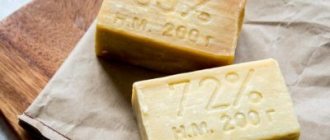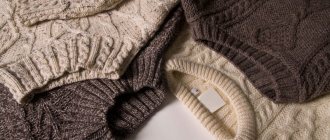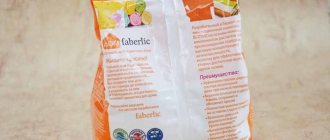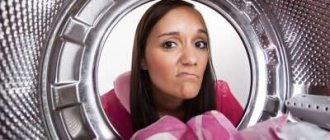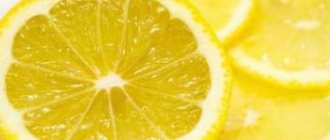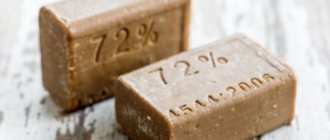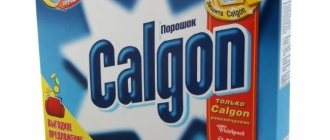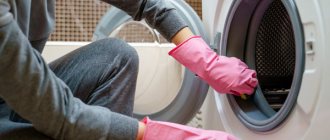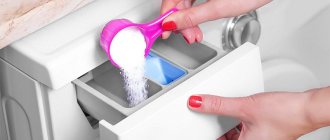Today we often hear about the dangers of washing powders, which are dangerous to human health and the environment. These products are being replaced by concentrated phosphate-free powders with natural ingredients and liquid washing gels with a mild, gentle effect.
However, such products are quite expensive. Therefore, many people ask whether there are accessible and inexpensive analogues of bulk detergent that can be used in machine washing. Let's look at how to replace washing powder.
Why is washing powder harmful?
Surfactants (surfactants), phosphates and zeolites, fragrances and enzymes, flavors and dyes, defoamers and other aggressive additives - this is what washing powder for a washing machine is made from. Many of these elements are harmful and dangerous. Zeolites and phosphates in washing powder often lead to skin irritation and allergic reactions.
Many washing powders generate dust and form powdered lime, and after washing they leave marks and stains. This causes discomfort, worsens the condition of things and also leads to allergies. How an allergy to washing powder manifests itself, see here.
With regular washing with bulk substances, clothes gradually wear out, lose quality, color and presentable appearance. This is especially true for delicate fabrics, including lace and satin, silk and wool. In addition, powders are harmful to ecology and the environment, since the composition does not disintegrate or break down.
To reduce the harm of bulk detergent, many are switching to environmentally friendly phosphate-free powders. This is a safe product that does not cause allergies and does not harm the environment, as it completely dissolves and breaks down into organic substances.
It is suitable for everyday washing and works even in cold water, but is expensive. But you can replace washing powder with more affordable folk remedies.
Laundry soap
The advantages of using laundry soap for washing are the following effects:
- disinfectant;
- whitening;
- removing stains of organic origin.
The product does not damage the fabric. After using it, the laundry becomes clean and pleasant to the touch. However, when washing colored items, it can cause them to lose their brightness. Laundry soap is not effective against stains of inorganic origin. This folk remedy is not effective enough against complex stains.
To wash things with laundry soap, you need to first grate it on a fine grater. The presence of large pieces in the total mass is unacceptable. Soap stains will remain on things. Fine soap shavings are poured with warm water and mixed thoroughly. The soap should completely dissolve. The resulting substance is poured directly into the drum of the washing machine, after loading dirty clothes into it.
Soap shavings are preferable for hand washing.
Use it in the car with caution. The product tends to stick to the internal surfaces of a household appliance, enveloping them
This threatens to render the washing machine unusable. You can prevent damage by thoroughly cleaning the interior of the equipment from soap deposits after each use of this folk remedy.
Folk remedies
A solution of baking soda and borax can remove stubborn stains. To do this, take 200 grams of each substance and mix. The mixture should be stored in a dry container with a tight-fitting lid. When washing, use 30 grams of the resulting product per two kilograms of laundry.
Pour the powder into a regular glass and pour in hot water until the end. Mix the composition and add to the powder compartment. Wash at 40-60 degrees. In colder or hotter water the components will not have the desired effect.
A recipe using a more expanded list of ingredients will be more effective when washing. Take 200 grams of baking soda, table salt, borax and 100 ml of wine vinegar. Wine vinegar will act as a conditioner. It will soften the water, give things softness and a fresh aroma. Leave the vinegar separately and mix the remaining ingredients.
Use the resulting product at the rate of 40 grams of powder and two teaspoons of vinegar per two kilograms of laundry. The mixture is placed in the main compartment, and the vinegar in the conditioner compartment. It is advisable to wash things in warm water.
Experts do not recommend using homemade powders all the time, as they will not cope with washing 100% and will not be able to remove difficult stains. In addition, folk remedies are not suitable for fading fabrics and are ineffective for colored items. But you can alternate between store-bought and homemade laundry detergents in the washing machine. This will save money and preserve the quality of things longer.
Perox
A universal cleaning product that can also be used for laundry is bleach, but it does not contain chlorine. This product copes well with all types of dirt and stains, and to add fragrance to the laundry, you can drop a couple of drops of any synthetic fragrance into the drum. For one wash cycle you will need about 100-150 ml of product.
As you can see, you can often do without powder, but provided that you choose the right replacement, even if it’s temporary.
AlinaAuthor of the article
Did you like the article?
Share with your friends:
What not to use
Many recipes using soap are not machine washable. The soap forms a lot of foam, in addition, the remaining product settles in the tank, drain, filter and drain of the machine. As a result, this disrupts the operation of the washing drum, clogs the holes and disables the equipment.
For the same reasons, the following components and solutions cannot be placed in the automatic machine:
- Solid and liquid soap, soap shavings;
- Vinegar, acids, alkali;
- Mustard powder;
- Plants in crushed form with large fractions.
Even with timely cleaning of the washing machine, the risk of equipment breakdown when using the above components remains very high. But such products are well suited for hand washing. Use acids and alkalis with caution. They will remove old dirt and stubborn stains, but are not suitable for washing children's clothes.
Acids and alkalis can cause severe skin irritation. It is advisable to wear rubber gloves when working with such components. But vinegar can be added with each rinse to make things soft. You can soften water using special filters and traditional methods. How to do this, read the article on how to purify tap water.
Beans
Few people expect such uses from beans. But it is she who is able to quickly and effectively wash woolen items. Moreover, you have waste-free production. The beans can be used as a side dish, and the water in which they were boiled is suitable for washing. To wash by hand you will need 200 grams of beans, pour one liter of water and cook. After cooling, strain the broth through cheesecloth and pour it into a bowl of water, while whipping up the foam. After the washing is completed, the laundry should be rinsed thoroughly and when rinsing, add one tablespoon of vinegar to a bowl containing 1 liter of water.
Liquid washing gels
Washing powders can be replaced with liquid gels. By the way, such products are specially made for safe washing in an automatic machine. The gel is a liquid-like composition without phosphates and with a minimal amount of surfactants.
The gels are distinguished by a convenient dosage, since the product is measured using a cap from the packaging. In addition, the product is convenient to store in a compact container that does not take up much space.
The gel also differs in that it contains titanium dioxide and similar substances that help maintain the whiteness and freshness of products. Such elements are not washed out after washing and protect the fibers of the materials, preventing further contamination.
Liquid detergents act delicately on fabrics, are completely washed out and leave no traces, and retain the shape and original appearance of products. They are optimal for young children, people with allergic diseases and weak immunity.
Please note that gels cannot be used for hand washing because the substances in the product require special activation, which is only possible in an automatic machine.
In addition, it is recommended to dilute gels with warm water at a temperature no higher than 40 degrees, since in hot water the elements from the composition are destroyed and stop working. When washed in water temperatures above 60 degrees, the gels will not be able to remove stubborn stains from grass and cosmetics, food and drinks.
LiveInternetLiveInternet
Quote from Velvet_Hat
Read in full To your quote book or community! How much washing powder to put in the washing machine SOURCE
Most housewives don’t even think about the fact that they use a lot of powder when washing. Most often, everything is poured “by eye”, according to the principle the more, the better. Such actions can cause not very pleasant consequences, such as: White stains on clothes after washing. Clogged washing machine container. Unpleasant smell from the drum. So how much powder should you pour into the washing machine? Let's figure it out. Instructions from the manufacturer
Instructions for washing powder
When purchasing powder, do not rely too much on the proportions indicated on the pack itself. The goal of any manufacturer is to retain the buyer and force him to use as much of the product as possible.
The amount of powder in the instructions is 3 times the amount that is actually needed for washing.
If you believe everything that is indicated on the packaging, you should spend a pack of powder weighing 450 grams for 2 washes! In fact, the norm is 1 tbsp. spoon of powder for 1 kg of dry laundry. This amount is quite enough to wash clothes and extend the life of the machine.
Markup in a container
The process of pouring powder into the container If you look at the powder container in any washing machine, you will see a small mark. This is the designation up to which you need to add detergent.
But don’t rush to be guided only by the mark. When calculating the required amount of powder, manufacturers take clothing with stubborn stains as a criterion. In addition, it is unknown what kind of powder was used in the experiments: concentrated or not.
The mark is created to ensure that you do not pour more powder than the machine needs for normal operation.
Repairman's advice
Service center employees or a household appliance repairman are best aware of the ideal proportions of laundry detergent. They all agree that 2 tbsp is enough for intensive washing. spoons of powder per 1 kg of dry laundry or 5-6 tbsp. spoons when the washing machine is fully loaded.
If you are going to wash clothes without serious stains, 1 tbsp is enough. spoons of washing powder 1 kg of clothes.
In addition to expert opinion, there are external factors that can affect the required volume of laundry detergent:
*Water quality.
*Wash type.
*Powder.
Water quality
When washing in hard water, you will use more powder than when washing in soft water. Setting the water type is very easy
You need to run an empty machine for a quick wash without powder, and during the procedure pay attention to the glass of the machine. If bubbles appear on it, the water is soft; if not, the water is hard.
For washing in soft water, just add 1 tbsp. spoon of powder, if the water is hard, use 2 tbsp. spoons.
Washing type
The volume of powder for intensive and hand washing is completely different.
If you are loading work clothes, add 1.5 tbsp per 1 kg of laundry. spoons of powder.
To remove stubborn stains, increase the dose to 2 tbsp. spoons
Powder
If you use regular washing powder (“Gala”, “Ariel”, “Tide”), the proportions remain standard - 1 tbsp for 1 kg of washing. spoon.
It's another matter when you use concentrated laundry detergents - these are well-known Amway products or Japanese powders.
For one washing session of a completely filled machine, you should use no more than 2 tbsp. spoons of concentrated powder.
If you overdo it, you will have to rewash all the laundry again - white stains will remain on the clothes. It's easy to extract the ideal amount of laundry detergent. Believe me, it is much easier to take into account all the factors and make calculations once than to wash the laundry several times or take the washing machine to a service center for repairs.
Benefits of washing gels
- Accurate and convenient dosage;
- Convenient storage;
- Eco-friendly and natural composition without phosphates and aggressive components;
- Provide gentle care for woolen and silk items;
- There are no harmful emissions, which ensures 100% safety for the environment;
- Safe for allergy sufferers and children;
- They dissolve and wash out well, do not leave light spots, marks or streaks;
- Gently clean the fabric and do not destroy the structure of things, protect color and shape.
How to make washing gel
You can also prepare liquid gel yourself. Take two liters of water, 100 grams of baking soda and laundry soap. Grate the soap on a coarse grater and add water. Then place on the stove and melt over low heat until the soap is completely dissolved. After this, add soda to the solution and mix well.
It is important that the soda dissolves completely, otherwise it may leave streaks, marks and light spots on dark or black clothes. The resulting composition is left covered for a day, then poured into a container and used if necessary. Baking soda reduces the volume of soap suds, so this gel can sometimes be used in automatic machines. But this product is more suitable for hand washing.
Salt
The use of salt is most effective for washing linen and cotton clothes, and you can wash both white and colored items. The process looks like this:
- You need to place things intended for washing in a large container;
- Next, water is poured, the volume of which should be remembered;
- After this, things are thoroughly wrung out;
- You need to dissolve salt in the remaining water (one tablespoon per liter of liquid);
- Things are soaked in the solution for one hour;
- After this period, the clothes are wrung out and rinsed.
Six best washing gels
- Persil Gel is the most popular and affordable product in this category. It protects color and removes stubborn stains and works at low temperatures. The gel can replace washing powder in terms of washing quality and efficiency. At the same time, it contains a safer composition. But this product is characterized by fast consumption and high price;
- Wellery has received a lot of positive reviews, despite the high cost. This product prevents color fading and preserves the aesthetic appearance of products for a long time. In addition, this gel is gentle on fabric and is suitable for washing silk, wool and other delicate materials. Wellery is characterized by a light fresh aroma, safe composition and thick texture, practical packaging and economical consumption;
- Synergetic is a universal hypoallergenic product from Germany that is perfect for washing baby clothes, delicate fabrics and other types of material. The light consistency of the gel foams well and is washed out of the fibers in a few seconds. However, Synergetic is quickly consumed and will not be able to remove old stains;
- Ariel is an economical and affordable product, suitable for colored and white linen, children's clothing and for allergy sufferers. The gel is distinguished by its versatility and high efficiency. It easily dissolves in water and is washed out, effectively removing stains and dirt;
- Power Wash is another versatile product that works on every type of fabric, including lye, satin and wool. It effectively removes stains and protects color. Can be used for colored and white clothes;
- Ushasty Nyan is a popular Russian brand of detergents for newborns and children. Can be used for babies from the first days of life, including for washing baby vests and diapers. In addition, this gel is suitable for disinfecting children's dishes, bottles, and toys. It kills harmful germs and bacteria. However, many mothers note the appearance of an allergic reaction in their babies.
Liquid gels are suitable for everyday and frequent use, for washing children's clothes and delicate fabrics, as they are gentle and gentle. In addition, this is an indispensable product for allergy sufferers and people prone to allergies and skin irritation. But strong and difficult to remove stains, as well as linen and cotton, can only be washed with washing powders.
In the latter case, it is important to choose a safe composition that will cause less harm. You need to be especially careful when choosing washing powders for children's clothing. These must be special products appropriately marked “for children” or “for newborns.”
Natural concentrated powders without phosphates are perfect for safe washing. More detailed information on how to choose washing powder can be found at the link.
Details
Ingredients included in the natural powder
- Soap is the main component of natural laundry detergent. Any soap is suitable for these purposes - toilet, baby, laundry. To obtain the most natural product, you will need castile soap made from olive oil or glycerin bar soap. A very good option is regular laundry dark soap 72%, because it has the greatest activity and has the ability to soften fabric fibers, which is necessary especially when washing children's clothes. Remnants of soap, which are usually thrown away, are suitable for such purposes. This will make your laundry detergent even cheaper.
REFERENCE! To prepare washing powder, the soap must first be dried a little, for which it is removed from the packaging and placed in a dry place (in the sun or near the battery). After this, the soap can be crushed.
- Baking soda - used instead of bleach and other active ingredients included in each product. Baking soda is an excellent cleaning agent that can be purchased at any grocery store and is inexpensive. Being part of a homemade washing powder, it cleans the fabric fibers without damaging them. In addition, thanks to it, things retain their whiteness and odors are neutralized.
- Soda Ash - used to soften water. It has the same properties as food, but has a much higher concentration and, accordingly, activity. The well-known Calgon contains soda ash, and people buy it to get rid of scale. In fact, you can do without expensive Calgon if you add a little soda ash.
- Borax is a necessary component of homemade powder. This is the name of sodium boric salt or sodium tetroborate. Borax has a very strong disinfectant and cleaning effect, so it is often used to make products that cope with washing clothes for children. You can buy borax at hardware stores and pharmacies.
- Essential oils - added for a pleasant aroma of laundry after washing. In addition, they also disinfect things. Essential oils contain beneficial components that partially remain on the fabric and come into contact with the skin, having a positive effect on the body. For example, tea tree oil has an antifungal effect and is good to add when washing children's clothes. Citrus essential oils dissolve fat well. During colds, it is better to add essential oils of eucalyptus and mint.
REFERENCE! Lavender and chamomile oils have a relaxing and calming effect.
Recipes at home
There are many ways to make your own laundry detergents. Many of them are known to a large number of people and have been used by them for a long time. There are three most common recipes for a natural laundry detergent, the ingredients of which cost little and also do not take much time from the housewife. If the proportions are not observed slightly, this will not affect the washing result in any way.
Second way
A simpler option without borax. Ingredients:
- soap crumbs - 1.5 cups;
- baking soda -2 cups;
- soda ash - 2 cups;
- essential oil - also in the amount of 10-15 drops, added as desired.
The third method is children's washing powder
Used for washing children's clothes. Ingredients:
- soap crumbs - 150 grams;
— baking soda — 500 grams;
- borax - 200 grams;
- tea tree oil - 3-5 drops.
The recipes for preparing the powder are simple, but the benefits of using them are enormous.
Preparing laundry detergent
- First you need to make small crumbs out of soap. This is done by rubbing a bar of soap on a fine grater.
Then you need to mix all the ingredients in the following order - mix soap crumbs with soda ash, then add borax, baking soda and at the very end add a drop of essential oil. All components must be mixed well and poured into a glass or plastic container for washing powder, in which the product will be stored.
It is important that the container is tightly closed with a lid. Containers with powder should be stored in a cool, dry place.
